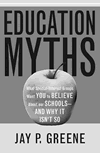
Education Myths: What Special Interest Groups Want You to Believe about Our Schools—And Why It Isn’t So.
Jay P. Greene, with Greg Forster and Marcus A. Winters. Foreword by James Q. Wilson. (Rowman & Littlefield Publishers, Inc.)
Buried within this book is a powerful if familiar argument: the American education system is worse than we think and won’t improve unless we change the incentive structure that drives it. Resource levels are hardly the main problem, say the authors; nor is increasing them a likely solution to our schools’ ills. Choice and accountability, which focus on changing the incentives, offer a promising way forward.
What is unique about this concise volume is the authors’ systematic debunking of an array of myths—18 in all—that grip our beliefs about how schools work. At the same time they expose the ways that potent interest groups feed the myths and interfere with the authors’ reformist vision. The task of reform is, of course, Herculean, and critical readers will remain unpersuaded by one or two of the arguments. But the rigor, clarity, and energy with which the authors press their case make this book one the teacher unions do not want you to read.
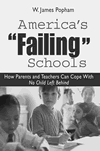
America’s “Failing” Schools: How Parents and Teachers Can Cope with No Child Left Behind.
W. James Popham. (Routledge.)
Popham has written a volume that indulges in flights of hyperbole yet retains a tone of serious scrutiny about NCLB accountability. The author establishes his sincerity early, dismissing complaints that NCLB is underfunded as a “phony” dispute. However, even as he is offering this sensible observation, he is explaining that NCLB, “even with super-abundant funding, will be ruinous for our schools.” Popham’s criticisms encompass the savvy as well as the silly. He reasonably dings NCLB for the tests the states use, for the crudeness of the adequate yearly progress (AYP) determination, and for the gamesmanship allowed in state AYP timelines. But then he also drags out old tropes about excessive test preparation and the ethical issues posed by such practices. Moreover, despite pointing out the difference between accountability systems and particular assessment instruments, the author frequently appears to attribute the problems of mediocre state tests to NCLB itself. While Popham’s preferred solutions may cause some chuckles among accountability proponents—he champions the use of “affective inventories,” student work samples, and the like—his analysis constitutes a meaningful critique of the NCLB accountability system and raises hard questions that NCLB proponents need to address.
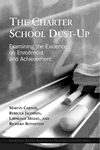
The Charter School Dust-Up: Examining the Evidence on Enrollment and Achievement.
Martin Carnoy, Rebecca Jacobsen, Lawrence Mishel, and Richard Rothstein. (Economic Policy Institute and Teachers College Press.)
Paul Hill, chair. (The Brookings Institution Press.)
Charter schools are new, diverse, and subject to close scrutiny. That combination necessarily produces research findings that are preliminary, inconsistent, limited, and subject to error. Even the high-quality articles on charters in the research section of this issue of Education Next (see pp. 51-66) do not find common ground.
To make sense of all the complexity, there is an ever-growing need for dispassionate summaries that give outsiders a sense of the overall picture while sifting the wheat from the chaff. In this regard, the National Commission report issued by the centrist Brookings Institution remains a good place to begin, despite the fact that it is a bit boring and dated (2003) by the standards of the fast-changing world of school choice.
A more recent contribution, by the left-leaning Economic Policy Institute, is quite otherwise, on the dispassion index, at least. Although charter schools, with all their diversity, have gathered support across the political and education spectrums, from phonics fanatics to Summerhill progressives, the senior authors of this work remain well-entrenched critics of choice. Instead of weighing evidence in the balance, they search for findings they want to believe. For example, the study devotes considerable space to a couple of unrepresentative schools as if they were characteristic of all charters, thereby ignoring the extraordinary diversity of a new world still searching for its identity. The Dust-Up authors also use error-ridden information about a child’s food stamp eligibility to argue, unconvincingly, that charter schools tend to serve the better-off segment of the minority community.
Above all, an inordinate number of words and pages are devoted to laying out what is depicted as zealotry and inconsistency among other participants in the debate over school choice, as if that tells one anything about the schools themselves. Although the authors are to be applauded for wanting to hold charter schools accountable to high performance standards, that does not save Dust-Up from being best assigned to the dustbin.
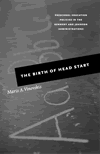
The Birth of Head Start: Preschool Education Policies in the Kennedy and Johnson Administrations.
Maris A. Vinovskis. (University of Chicago Press.)
Eminent education historian Maris Vinovskis has crafted a thorough account of the creation and launch of Head Start. The pleasantly brief text, which spans just 155 pages, offers a clear explanation of how anti-poverty policy, national politics, education policy, and changes in views of child development shaped the program in the 1960s. The author concludes that an emerging belief in the malleability of children’s intelligence, the “discovery” of poverty in the early 1960s, Lyndon Johnson’s energetic education agenda, and the Democratic majority that passed the Economic Opportunity Act of 1964 combined to make Head Start possible. Be advised that the volume is a history in the most descriptive sense. Vinovskis provides a careful, blow-by-blow account of the legislative politics and executive decisions that shaped the program rather than an assessment of those decisions. The volume also does not draw links to, or follow implications for, contemporary policy debates; nor does the author explain how early compromises and decisions affected subsequent developments. Finally, the general reader should be forewarned: the narrative ends abruptly in 1969.
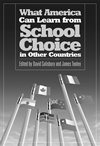
What America Can Learn from School Choice in Other Countries.
David Salisbury and James Tooley, ed. (Cato Institute.)
Only a little, one might conclude, after reflecting on the essays in this collection. Although James Tooley reveals a lively private education sector in the most unlikely of places (see also Tooley’s story “Underground Education,” p. 22, this issue), school choice is as uneven and limited in other parts of the world as it is in the United States. The disputation over Chile’s voucher experiment is vigorous, but even there the constraints on the education marketplace are substantial. And New Zealand’s choice system is so narrowly constrained to government-run operations that the innovation would be totally ignored had folks there not had the same political and linguistic ancestry as those populating the United States. Still, even a modicum of school choice and competition can boost student test scores, especially when combined with a comprehensive examination system for high-school graduates, says Ludger Woessmann, whose systematic, sophisticated analyses of international test-score data best summarize what can be learned from abroad. By itself, this lay-friendly summary of Woessmann’s more technical studies makes the book worth the price.


